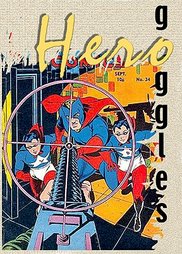Face: 1946, Planet Comics #44 (Holyoke). Bald-headed master criminal and foe of Mysta of the Moon. He wore goggles and round ear pieces in issue 44. In issue 45, he wore a hood similar to a gas mask that covered his whole head. He manages to get a stooge planted with Mysta's crew, impersonating Bron, a talented student. However, Bron ultimately sides with Mysta and turns on the Face, killing him.
The Faceless Phantom: Thrilling Comics #1 (Standard). Doesn't that just sound like a natural bad guy for Scooby Doo and gang? Anywho, Bob Jase writes me: The first opponent of Dr. Strange, he wore a skull mask & had synthesized a formula that gave him just slightly less strength & durability than Dr. Strange. Apparently killed at the end of his 1st appearence, he returned in Thrilling Comics #7 with a new formula to equal Doc's (who got less formal in that issue). Unfortunately for the Faceless Phantom, Doc had just redesigned his own formula so that he could fly. The Phantom couldn't & apparently died in a fall from an airplane while fighting Doc. He even made the covers a few times: Thrilling Comics (1,7 and 36)
Faces Benny: 1936, Detective Picture Stories #1 (Centaur). Faces is a “man of a thousand faces”, a clever and quick make-up artist. He runs “The Night Owl” roadhouse and has a scam to pad bills of inebriated customers. He gets into an argument with one customer and accidentally kills him when the man hits his head after being knocked out. He has his man quickly dump the body while he passes himself off as the victim to the man's date in an effort to make it look as if the drunk man was killed after leaving the restaurant. The body is discovered too soon, though and detective Pat O'Day realizes something is up when he is contacted by the man's date who claims she was still with her date at the time his body was being found.
Faken, J.J.: 1939, Mystery Men Comics (Fox). Faken gets boys out of reform school and then trains them to be real crooks: pickpockets, second-story men, etc. The tables are turned when the Green Mask investigates the recent crime wave.
The Falcon: 1937, The Comics (Dell). International man of evil, he kidnaps Dr. Doom's son and holds him in Marovia in exchange for secret war plans.
The Fang: 1941, Fantastic Comics #17 (Fox). Bald master criminal, he fought the Black Fury throughout his run. In his second appearance, he had the power of invisibility (possibly obtained from an emerald that had carvings that were supposed to reveal the secret of invisibility that was in the care of the Black Fury).
Fang II: 1944, Tally-Ho Comics #1 (Swapper's Quarterly/Baily Publications). Fang is a green skin villain, a face not too unlike a crocodile's crossed with the GA Red Skull, and wearing red robes. He's got some ability to bring forth imaginary monsters who can wreak very real and deadly damage. We first see him on Desolation Island, a dismal gloomy island where various cutthroats and pirates can find refuge. He's too evil for even them and they bind him and take him to the Arctic where they hope the cold will kill him. However, as soon as he manages to free himself from his bonds (maybe his powers don't work while tied?) he calls forth a sea serpent to destroy their ship. Then he calls forth an army of savages to attack a group of Eskimo natives. They have protection of their own and pray for the "mighty one" to save them. An idol of an ice man with a blue baseball cap, buttons and boots, smoking a pipe and holding a hatchet comes to life as Snowman and fights Fang. Fang briefly gets the upperhand and somehow manages to create a semi-tropical underground lair with crocodiles where he can plan his global conquest. Ultimately, Snowman defeats him and Fang falls victim to his own crocodiles. Whew.
Fantasy Isle: 1941, Silver Streak #7 (Lev Gleason). Silver Streak investigates the deaths of several people from the "Fire Death". His investigation leads him to a strange island in the Pacific manned by a race of monstrous humanoids, no two looking alike. Over the years they have imprisoned those that discovered their presence and see Silver Streak's arrival as proof that their existence has become known to the outside world and they must destroy America before they are destroyed. However, Silver Streak leads an uprising of their prisoners. Many of the island's inhabitants are killed during it and the rest Silver Streak dumps in the ocean. He tells the prisoners that a rescue ship will be there soon but not to tell of what happened (although how the prisoners are going to explain the rather fantastical surroundings, dead bodies, how they got there etc is left unexplained).
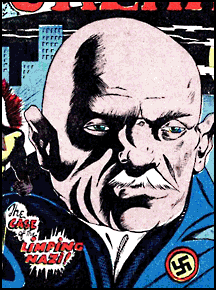 Fat Man: 1944 Captain Flight #5 (Four Star). The Fat Man, also called the Limping Nazi (he uses a cane) is head of a group of spies. When his men kill Danny Corbet, by accident they end up motiving his brother Bruce to become the hero the Grenade. Part of the group is a monstrous man-beast he uses to kill the henchmen who screwed up, but the man-beast gets a bloodlust and they are forced to kill him too.His right-hand man is Longo. The Grenade makes good on
Fat Man: 1944 Captain Flight #5 (Four Star). The Fat Man, also called the Limping Nazi (he uses a cane) is head of a group of spies. When his men kill Danny Corbet, by accident they end up motiving his brother Bruce to become the hero the Grenade. Part of the group is a monstrous man-beast he uses to kill the henchmen who screwed up, but the man-beast gets a bloodlust and they are forced to kill him too.His right-hand man is Longo. The Grenade makes good on 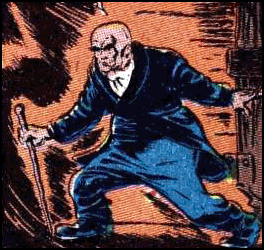 his threat and kills the gang the same way they killed his brother, with a hand grenade. The wiley Fat Man escapes though and takes off in a plane. The Grenade follows and the Fat Man is shot down.
his threat and kills the gang the same way they killed his brother, with a hand grenade. The wiley Fat Man escapes though and takes off in a plane. The Grenade follows and the Fat Man is shot down.
Faux Heroes: It is a long practice of the enemy, whether enemy soldiers or that undesirable criminal element, to strive to replace the hero with one of their own. Some have the abilities to mimic their foes, others just get by on audacity and their acting. Regardless, they are all bad actors...
Ajax: 1940, Doc Savage Comics (Street & Smith). A crook who bears a resemblance to Ajax, puts on a costume and passes himself off as the hero. As he doesn't have any of Ajax's powers, he and his comrades use trickery to fake them.
Blue Beetle: 1943, Blue Beetle #27 (Holyoke). Captured Nazi spy Fritz looks enough like Dan Garrett and the Blue Beetle that he's bribed to go to Germany and operate some as the Blue Beetle to confuse things. However, once over there, he gets greedy and the FBI suspect a triple cross and send the real Blue Beetle to investigate. NOTE: This story doesn't make much sense as it seems that Garrett is working with the FBI and not the police and that his dual identity is not terribly secret. Nor is Fritz' final fate and true loyalty ever sure.
Clock: (Centaur). "Chief" Browser and henchman Clarence "Muscles" McGee rob and murder a man and leave calling cards like the Clock in order to frame him and get the police hot after him. Investigating, the Clock finds a clue that leads him to the pair. Chief is slain when he trips a trap that was geared up for the Clock. Out fought, Muscles signs a full confession.
Green Hornet: see Baron Satakai.
Green Mask: 1945, Star Studded Comics #1 (Cambridge House). La Verne and Tiny (a short man) are acrobats in the circus. On the side, they masquerade as the Green Mask and Domino, committing daring robberies and shooting innocent bystanders.
Green Turtle: 1944, Blazing Comics #3 (Enwil). Anthony Durrant writes: This gentleman was Lieutenant Tasatu of the Japanese army; he was disguised as the heroic Ching Quai, aka the Green Turtle, and led a group of Chinese raiders into an ambush in Go-Wai Village at the behest of his master, General Kimonak, who then wiped out the raiders. Using a duplicate of the Green Turtle's rocket plane, the Lieutenant was trying to destroy the good name of the Green Turtle. Tasatu was eventually shot down by Burma Boy, and the General was taken into custody and committed seppuku shortly thereafter. As Burma Boy remarked: "General Kimonak's entire staff committed (seppuku) after his death. Is it not wisely said that he who plans a trap will often fall into it?"
Man of War: 1942, Man of War Comics #2 (Centaur). An imposter sent to kidnap General LeSan and lead the French forces fighting the Italians in Syria into an ambush. Which almost worked even after the real Man of War got involved, rescuing the general and helping fight off the enemy soldiers. I'm noticing these faux heroes, tend to be of normal people mimicking very powerful heroes.
Mask: 1940, Exciting Comics #4 (Better). Dennis Durrant illuminates: When the beautiful Broadway star Sandra Cummings committed suicide in her dressing room, she left a suicide note in which she named the members of a graft ring. The note was taken from the detective who found it by a gangster who was then surprised by the Mask, aka District Attorney Anthony Colby. The leader of the graft ring then turned off the dressing room lights and seized the note from the Mask, but not before the Mask memorized the names of the members of the graft ring. This individual then disguised himself as the Mask and teamed up with gangster Patrick O'Rooney to terrorize the members of his own graft ring. He succeeded in killing three of those members - leaving the sign of the Mask beside each one - before being shot dead by the Mask and unmasked as Dr. Lawrence Reid, a close friend of Sandra Cummings. Reid himself had been the man behind the graft ring, and Sandra had chosen to take her own life rather than be blackmailed by him.
Mirror Man: 1944, Jim Hardy (United Features). The Torpedo is king of the gambling rackets. When he captures the hero Mirror Man, he decides to besmirch the hero's identity and use his powers to hold up banks. However, he does not realize that the mystical garment cannot be used for crime and when he tries to escape the bank by jumping through a large mirror, he shatters it and kills himself.
Mr. Universe: 1951, Mr. Universe #1 (Media) The fake Mr. Universe is an ex-con by the name Al Burche. Near the end of his sentence, he is given Silas Cratchett as a cell-mate. Cratchett has been sent to prison based on testimony given by the wrestler. Noticing the uncanny resemblance, he concocts a needlessly complex plan of revenge that centers on training Burche mentally and physically into a duplicate of Mr. Universe, so that he could fool even his closest friends. Which he does. The plot seems to center on worming his way into Universe's pals Scarcely's and Clayton's confidence. A fake manage is to ingratiate himself with the real hero with a plan to assert his identity by agreeing to a match as the counterfeit wouldn't be able to match his skills in the ring. Then during the match, a bomb would be set off killing his friends, framing Mr. Universe as being the ex-con Al Burche while Burche continues to pass himself off as Universe. However, Mr. Universe sees through the fake manager and is combing official records for anyone reported to resemble him. He turns their own game on them, the match is at a time and place of his choosing not theirs and the night before the match, the crooks beat up the imposter thinking to be softening up Mr. Universe. Ultimately, all the crooks are captured and go to jail for a long time.
Phantom Falcon: 1942, Cat-man Comics #13 (Holyoke). The Phantom Falcon is trying out his new plane after his last one was crashed when he spots a duplicate of his plane in the skies. The two have a deadly duel, and it's all he can do to shoot down his duplicate, though behind enemy lines. He lands in order to get a look at his imposter and is surprised to see a female spy who had hoped to fly the plane into England without being shot at. Her plans for mayhem in England are left undisclosed as he's forced to leave without her, though she'll have to find a different way to sneak into the country.
Phantom Lady: 1948, All Top Comics #14 (Fox). Toni and Rod Sanchez aka Laura and Juan Lopaz are wanted criminals for diamond smuggling, murder and embezzling. Knowing of Don Borden's infatuation with the Phantom Lady, they not only manage to befriend him, but Laura also disguises herself as Phantom Lady to make dates with Don in order to use him as a dupe in smuggling their diamonds in dead fish that they will "catch" while out fishing. Juan is killed when double-crossed by his gang because he won't cut them in on a bigger share. The rest of the gang and Laura fight the real Phantom Lady. Laura falls overboard and drowns herself while struggling before she can be saved.
Pirate Prince: 1941, Silver Streak #10 (Lev Gleason). "Beau" (always referred to in quotation marks so probably an alias) is a pirate longing for his home in Spain. When the Pirate Prince arrives in port, Beau has his girl Zara lure him into an ambush where he hopes to take all of the Prince's loot and force him to take him back to his country. He alters his plans when he realizes he bears an uncanny resemblance to the Pirate Prince. He shaves, cuts and dyes his hair and then takes over the Prince's ship, treating the crew with cruelty. However, the Pirate Prince escapes, disguises himself as Beau and takes Beau's ship, the "Eel", and confronts him on the seas. He reveals himself to his crew and then fights and kills Beau in a sword-fight, thus cementing his identity.
Pyroman: Startling Comics #34 (Better). A Japanese doppelganger who simulated his powers.
Rulah: 1947, Zoot Comics #10 (Fox). A cruel and murderous woman with a penchant for the whip uses her similarity to Rulah to pass herself off for her and steal rubies from an idol. Rulah ultimately captures her and restores the jewels. The fake Rulah is turned over to the natives for jungle justice.
Scarab: Exciting Comics#15. (Standard) Ramon Royale is a murderer and thief, he once tried to kill Peter Ward in an effort to steal some scarab statuettes. Nazi agents spring him from his Cairo prison, steal the scarab statuette and outfit him like the hero the Scarab in an effort to turn the Egyptian people against the Unite Nations. Only he is easily stopped by the real Scarab. There are several holes here. Ramon has a long then mustache and talks with a French accent so he doesn't make for a convincing Scarab even without the powers. And, the reason behind the theft of the statuette is not really explained either.
Shark: (Centaur) Anthony Durrant provides: This clown was a surgeon who looked like the Shark, the Golden Age undersea crime fighter, and who had opened gills in his own neck in order to breathe underwater. The fake Shark began a crime wave disguised as the Shark, who, unfortunately, captured him. The fake Shark bore an uncanny resemblance to the real Shark but did not have his webbed hands and feet.
Skywolf: 1943, Air Fighters Comics v2n1 (Hillman). Nazis manage to lead Skywolf and his band of fighters into a trap, wounding and capturing most of them. They replace them with their own group of look-alikes flying the squadron's own "semi-planes" and advertising that the famed squadron now flies for the Luftwaffe. Skywolf manages to turn the tables on them, capturing the Nazi impersonator and then pretends to be him, leading the fake squadron and tricking them into bombing one of their own plants. They get branded as traitors and while he rescues his men and makes his getaway, the fake Skywolf and squadron are executed as traitors. The Nazi Skywolf looks enough like the real thing, that even his girlfriend Greta cannot tell them apart. She had betrayed the real Skywolf to the Nazis and then inadvertantly betrays her boyfriend, thinking that he's the real Skywolf and that Skywolf had killed him. Thus, setting him up to stand alongside the others for the firing squad.
Sword, Lancer, and Merlin: 1944, Super-Mystery Comics v4 #2 (Ace)?. Fay Morgana (below) and her helpers the Hun and the Goth disguised themselves as the heroes that bedeviled them.
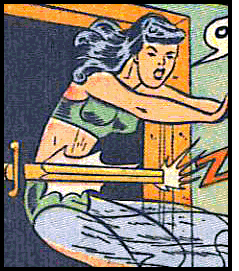 Fay Morgana: 1943, Super-Mystery Comics v3 #5 (Ace)?. Early, Morgana seems to be a Japanese agent in Chinatown with a gang of Asian cut-throats. She is captured by the Sword and Lancer when some lucky eggs that she had concealed plans in were accidentally bought by Su Chen in celebration of the birth of his first son and was handing them out to friends across the city, including the Sword's father.
Fay Morgana: 1943, Super-Mystery Comics v3 #5 (Ace)?. Early, Morgana seems to be a Japanese agent in Chinatown with a gang of Asian cut-throats. She is captured by the Sword and Lancer when some lucky eggs that she had concealed plans in were accidentally bought by Su Chen in celebration of the birth of his first son and was handing them out to friends across the city, including the Sword's father.
Later, she traded in her Asian looks and worked with the Hun ( a long-haired brute of a man), and the Goth (a bearded man looking like a viking) on behalf of Hitler as saboteurs and spies. However, they are stopped by the Sword, Lancer, and Merlin and dishearted enough to accept the aid of a dimunitive man calling himself the Genius. As the Sword and company make use of Arthurian myth and themes, a villainess with a name based on Morgan Le Fey is a natural.
The Fear: Yankee Comics #1 (Harry A Chessler). A masked and costumed axis (presumed German) agent. He had control of a witch who could use the hair of an individual to kill them by magic. They were killing key American military leaders when stopped by the fledgeling hero duo Yankee Doodle Jones and Dandy.
Professor Fenton: (Better). Inventor of a time machine, but uses his intelligence to head a gang and concoct schemes to steal money. Opposed by the mystical (Green) Ghost.
FFF: 1941, Captain Battle Comics #1 (Lev Gleason). Standing for Fire, Force and Fear, this is a vast league of green robed men seeking to subjugate America. They set their headquarters in Chicago and set about to bring the city to it's knees through murder and destruction. Their leader is Thompson, editor of The Midwest Nationalist and is stopped by Captain Battle.
The Fiend: 1939, Keen Detective Funnies v2 (Centaur). Criminal mastermind and foe of FBI man Dan Dennis. He has a satanic looking face and has created an "organ of destruction" that when he plays it, it can destroy objects or paralyze those that hear it.
Mr. Filch: Mr. Durrant provides: Mr. Filch was the man in charge of the reservation where the Princeton Lacrosse team's coach Eaglewing was living. Eaglewing was building an Indian village to honour his family, as he was the last of the elder Native Americans to be living on the reservation, the younger ones having gone away to fight in the war, but Mr. Filch refused to admit the public to see the village. Dick Cole's superior officer was a childhood friend of Mr. Filch's superior officer, and the man gave permission for the village to be opened to the public. However, Mr. Filch hired several hoodlums to pose as angry Native Americans and scare away the tourists. Dick Cole and the other members of his lacrosse team apprehended the hoodlums, and Mr. Filch was arrested by his superior officer, Mr. Dickon, for defrauding the government: all of the Native Americans he had been collecting funds and pension money had passed away years earlier. Mr. Filch was sent to a federal prison and Eaglewing was allowed to run his reservation as he saw fit. This was one of the few stories of its kind in the Golden Age in which Native Americans appeared.
The Finger of Frozen Death: 1941, The Flame #8 (Fox). A man is sending threatening letters to the construction workers of Woods' company who are building a large ice plant, and then killing them by freezing them solid. Woods thinks it's the work of a gang, trying to make him lose his government contract. Instead, it's his brother Randolph who is passing himself off as a corpse in a morgue with the attendent's help and putting himself into suspended animation. Randolph hates his brother, framed him years earlier in a phony stock swindle that Woods was afraid would come to light and make him lose his contract. The freezing invention is one of Woods that he had locked in a safe, apparently thinking it too dangerous or impractical. Randolph is seemingly killed when he releases the freezing vapor to kill his brother but the Flame's heat blows it back onto him and without his insulated suit, he freezes to death just like his victims.
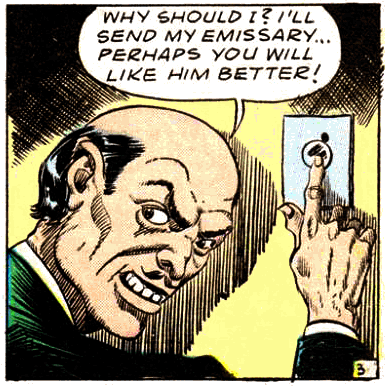 Dr. Finkle and the Indian Monsters: 1941, Four Favorites #2 (Ace Periodicals). Dr. Finkle is a Nazi agent. He was travelling the American West with his Asian servant Matsui with some men searching out a suitable location for a secret airbase. They come under attack by a group of American Indians unlike any other. Still dressed and equipped as if in the Old West, they are tall and possess wide-open eyes. The eyes prove key as when Finkle and his men fire upon them, they could not be hit by gunfire but effortlessly dodged the bullets. Panicking, Finkle accidentally kills one of his own men whom the Indians fall upon and start devouring. Killing another, the tribe sees Finkle as a benefactor. This is reinforced when he tells them that he was on a "holy crusade" to avenge the Indians against the white men and they willingly become his slaves. He uses them to rob and kill in order to send funds back to the Fatherland with them as willing slaves as long as he provides them with fresh meat. Finkle hates cowardice and kills Matsui when he suspects him of it. Preparing himself for possible conflict with superheroes, he built a house of non-magnetic materials, stymying Magno and Davy who find themselves involved with the case. Dr. Finkle is shot and left for dead by Betty, a secret service agent. With the death of their leader, the Indians now obey Betty. Their ultimate fate unsure.
Dr. Finkle and the Indian Monsters: 1941, Four Favorites #2 (Ace Periodicals). Dr. Finkle is a Nazi agent. He was travelling the American West with his Asian servant Matsui with some men searching out a suitable location for a secret airbase. They come under attack by a group of American Indians unlike any other. Still dressed and equipped as if in the Old West, they are tall and possess wide-open eyes. The eyes prove key as when Finkle and his men fire upon them, they could not be hit by gunfire but effortlessly dodged the bullets. Panicking, Finkle accidentally kills one of his own men whom the Indians fall upon and start devouring. Killing another, the tribe sees Finkle as a benefactor. This is reinforced when he tells them that he was on a "holy crusade" to avenge the Indians against the white men and they willingly become his slaves. He uses them to rob and kill in order to send funds back to the Fatherland with them as willing slaves as long as he provides them with fresh meat. Finkle hates cowardice and kills Matsui when he suspects him of it. Preparing himself for possible conflict with superheroes, he built a house of non-magnetic materials, stymying Magno and Davy who find themselves involved with the case. Dr. Finkle is shot and left for dead by Betty, a secret service agent. With the death of their leader, the Indians now obey Betty. Their ultimate fate unsure.
Because of their unique eyes, the Indians saw the world in slow motion, allowing them to dodge bullets, even fired at relatively close range. However, they proved less adept at dodging fists as Magno and Davy seemed easily capable of fighting them hand to hand. They are all tall and powerfully built.
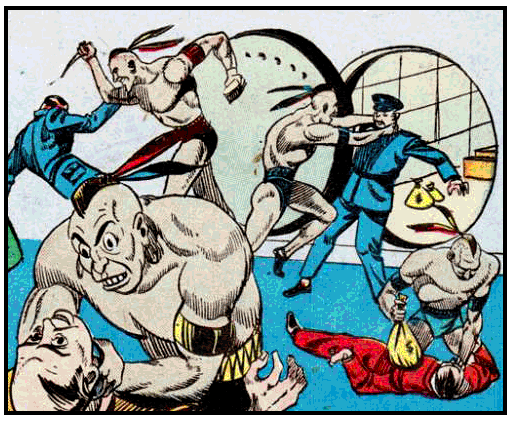
Fire of Kenya: 1943, Clue Comics #4 (Hillman) Anthony Durrant writes: Not a villain, but a stone ripped from the head of a sacred idol in Kenya. It has a curse on it by which everybody who comes across it is brutally murdered; a whole series of crooks try to claim the Fire of Kenya but are killed in the process. Finally, it comes into the possession of a man called Mike Jaram, who himself is murdered for the stone by Benny the Fence, a gangster who sells stolen goods. Benny is then brought to justice by the crime-fighter Micro-Face, who recovers a stone from Jaram's flat that turns out to be a copy: the real Fire of Kenya had been cut up into smaller stones five years earlier.
The Fly: December 1943, Clue Comics #6 (Hillman). Again from Ronald Byrd: A small yet apish genius, the Fly has trained himself to be strong and agile; he uses a rope fitted with suction cups to climb and sports a "poison tooth" to disable his opponents. Zippo catches him in the midst of sabotage, and he is jailed and seemingly slated for the electric chair.
The Flying Dragon: 1940? Silver Streak Comics (Lev Gleason). Foe of Sky Wolf (I).
Flying Dutchman: 1940, Fantastic Comics #13 (Fox). The Flying Dutchman is Captain Van Der Decken whose obsession to reach Flushing through a storm of Cape Horn had him and his crew cursed for eternity. Eventually, his crew tired of following the captain for eternity and mutinied. Since they couldn't kill him, they just cast him off and then turned to piracy. In the Badlands, he is still trying to reach Flushing only now driving a ghost car. His actions draw the attention of the Son of Aztlan who overpowers him and offers to re-unite him with his piratical crew which he does. A text story, there's no image of this version of the Flying Dutchman though he's described as having a red beard. No clue where he got his ghost car.
The Flying Ghost: 1940, Silver Streak Comics #3 (Lev Gleason). Great Nazi ace Von Gruber was shooting up the frontlines before disappearing. Shortly later, the Flying Ghost appeared, a yellow checkered German airplane with no pilot in the cockpit. He is finally brought down by Capt. Lee Curtis who is flying with a French squadron as America was not in the War yet. With no pilot to shoot at, Curtis opts for setting his ship on an intercept course and then bails out. Seaching through the wreckage they find that the plane was equipped with a second hidden cockpit in which Von Gruber secreted himself and flew the plane. The artwork to the text story, symbolically displays him as a skeleton pilot, not too dissimilar to the same company's hero, the Ghost.
Cindy Ford: 1946, Seven Seas Comics #1 (Leader Enterprises/Universal Phoenix Features). Female ship captain of modern day pirates and smugglers, and not above shooting to kill. She captains a submarine, equipped with a machine gun. She's referred once as “Cindy 'the Dolphin'” but everywhere else it's just “Cindy”. Captured by Sgt. Steve Badger and Squeaky, cops of the Harbor Patrol.
The Four: 1945, America's Best Comics 116 (Standard). Headed by Dagger Brent, a murderer six times over, the like-minded skillful group tries to seize control of a previously unknown Alaskan island to sell its location to hostile governments. They are stopped by the Fighting Yank. They dress in matching gray outfits with hoods and goggles ala the "Powermen of Mongo" and the only other member named is Gort Dagler, an international spy.
The Four Horsemen: 1943, Air Fighters Comics v2n1 (Hillman). Professor Blitzen is a mad scientist of Germany. He has created four extremely large planes with heavy armor, controls too large for a pilot to use and equipped with three heavy cannons and a dozen machine guns which would tear an average plane apart to fire. He was scoffed at by the commanders until they saw the proposed pilots for the planes, his four equally giant sons, each named after one of the four horsemen of the apocalypse. And, he has their names and symbols emblazened on the planes. Blitzen had been planning on this since Germany's defeat in the last war. They challenge the Allies to send their best aces to a duel over Rome. "Best Aces" includes Airboy and a few others not seen before. The Horsemen make shortwork of the other 3 and Airboy only succeeds in shooting down one, by firing on it from below. Over time, he and other RAF fliers manage to whittle down the Horsemen by exploiting their weakness until Death retreats back to his father, refusing to fly against Airboy. Blitzen himself flies the plane, after fixing the weak spot underneath. However, he loses Airboy in the clouds and opens his bulletproof canopy to try to spot him and Airboy swoops in from the side and kills him.
The Four Horsemen of Doom: 1944, Cat-man Comics #23 (Holyoke). Super-scientist for the Nazis, Dr. Grotz hooks up 4 volunteers to a strange machine and empowers them as embodiments of the four horsemen of the apocalpyse: Famine, Pestilence, War, and Death. They ravage occupied Europe until confronted by Cat-man and Kitten. Famine falls over a cliff when his mad charge is dodged by Kitten, Cat-man knocks Pestilence over the same cliff. Kitten uses a car as a bomb and War and Death perish in the flames.
Frankenstein Monster: Prize Comics (Feature Publications). The Frankenstein strip by Dick Briefer had a very schizophrenic run...sometimes horror, sometimes super-hero, and sometimes humor. The Monster had a healthy career opposed by his creator, by Bulldog Denny, and once by all of the denizens of Prize Comics (Black Owl, Yank & Doodle, Green Lama, Doctor Frost and a comical police duo).
Fraulein X: Bomber Comics. Beautiful but deadly Nazi spy. She sets out to ruin the tests of a new aviation fuel developed by Dr. Benson. Unfortunately for her, Dr. Benson is good friends with Wonder Boy who uncovers and stops her plot as well as capturing her.
Friar Diablo: Captain Battle Comics (Lev Gleason). This portly hunchbacked monk lived in a castle on a south seas island guarding an engraved sword that contained a clue to Captain Kydd's treasure. He promised Baron Doom to use his black magic to defeat Captain Battle and Hale in exchange for a share of the treasure. In the end, he is defeated when his magic wand shatters and brings the castle to ruins.
Frost: 1940, Wham Comics 2. (Centaur). An ice-encased villain, under orders of a foreign government, he uses his powers to sabotage the engines of a ship on which he has booked passage. When he takes his pills, he is not only encased in ice (though he has complete movement and can use a pistol), it also freezes things around him. His mere presence can cause frost-bite, freeze doors shut, and freeze ship motors. This bizarre act of sabotage brings him to the attention of the novice hero, the Blue Fire. The two find themselves at a stalemate as the Frost cannot harm Blue Fire who likewise cannot touch him. He manages to escape as the Blue Fire must leave before his powers fade and thus freeze to death. In a text story, he's described as being about 38 years old.
Fu Tong/Fong: 1941, Daredevil Comics #4 (Lev Gleason). Fu Tong had devised a plan of kidnapping Navy fliers and doping them in order to brainwash them to fly and bomb their own bases. The hero Nightro managed to put a stop to him before his plans reached fruition. On the splash page blurb the villain is referred to as Fu Tong. In the story itself he is called Fong.
Funnibone: 1942, Prize Comics, No 24 (Feature Publications) A fancy crook with a perpetual grin and twisted logic sets out to ruin America's steel production by targeting coal mines in a small Ohio town. The reason behind his actions is unknown; however, his plans are thwarted by the Black Owl (I) and his girlfriend Terry Dane. NOTE: I originally proposed that this character was a re-working of the Black Owl villain the Laughing Head. While one may indeed be based on the other (and both as dull versions of the Joker), they are separate villains as proven in a later issue when Funnibone is going up against the boy heroes Yank and Doodle, while in the same issue, The Black Owl takes on the Laughing Head. Both end up back behind bars where they belong.
